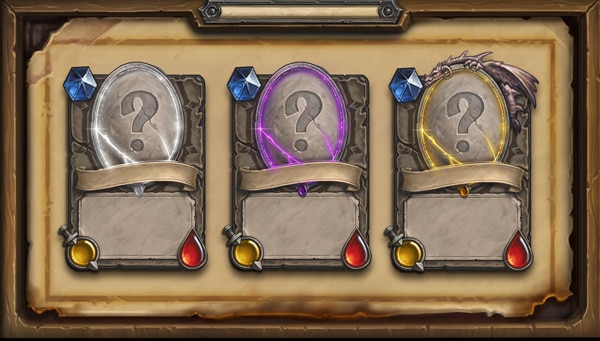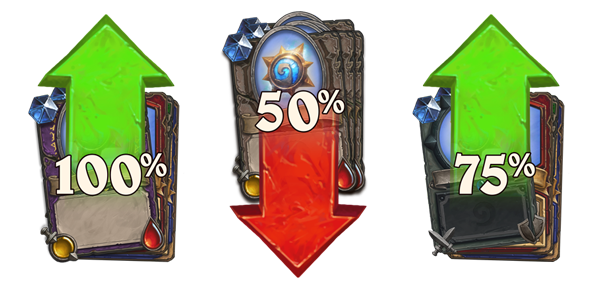Blizzard posted an interesting developer insights with Kris Zierhut that talks about how cards are distributed and how cards are weighted! It’s a good read if you want to learn more about the draft.
Arena is fun. It can also be quite a challenge. If you’ve ever wanted to get into the technical details about how an Arena draft works you’re in luck, because today we’re pulling back the curtain on what’s happening behind the scenes when you build an Arena deck!
An Arena draft is the process of selecting the cards that will be in your Arena deck for a single run of up to 12 wins or 3 losses. You are offered a series of picks, where 3 cards are displayed, and you pick one. After picking 30 cards, your deck is complete.
The Arena Buckets
The picks are organized around the concept of card “buckets”. A card bucket is a grouping of cards according to specific criteria, including how often they’re chosen during a draft and how often they’re part of a winning deck. The buckets are currently comprised of seven categories of non-Legendary cards and three categories of Legendary cards. The buckets are organized by performance quality, regardless of rarity. For each pick, the game chooses a bucket by weighted-randomness (I’ll explain that a little later), and then pulls three cards from that bucket.
You may wonder how cards get organized into buckets. For each card, we know how likely a player is to win a game if that card is in their deck. Cards are organized by their win chance, with similar values grouped into the same bucket. For example, when this system launched in 10.4, all the cards in bucket 1 were cards with a win chance over 53%. There are a small number of cards in bucket 1, with the number of cards in each subsequent bucket increasing as the win chance declines. We also know how likely players are to pick each card. Cards with very high pick rates are “promoted” a bucket, such as Obsidian Statue, which moved from bucket 2 to bucket 1 in 11.0. While cards with very low pick rates are “demoted” a bucket, such as Fire Fly, which moved from bucket 2 to bucket 3 in 11.0.
Arena Card Weight
Many cards have an increased or decreased chance to appear depending on what type of card (spell, weapon, Class card, etc.) they are. That becomes their weight. For example, a card with a 50% increased chance of appearance would have a weight of 1.5. The chance for each bucket to be picked is proportional to the total weight of all the cards in that bucket. A bucket with a total weight of 200 would have twice the chance of appearing as a bucket with a total weight of 100.
We currently use the following modifiers to the weight of cards: A 100% increase for Class cards, a 50% decrease for neutral cards from the Classic and Basic sets, and a 75% increase for spells and weapons. Note that because spells and weapons are also Class cards, these two modifiers multiply, giving those cards a net 250% increase (2.0 * 1.75 = 3.5). There are no bonuses for cards from the most recent set. Additionally, the lowest quality buckets have a reduced chance to be chosen.
Micro-Adjustments – The Little Things
We like to have each Class close to equal in power level in the Arena. To accomplish that, we have a system that tries to even out the win rates of Classes, using a process called micro-adjustments. The micro-adjustment process is a holistic algorithm that evaluates the win rates of all cards that can be drafted in Arena. We typically apply this process a couple weeks after each expansion, once the initial meta has become clear. The algorithm gives each card a value between 0.7 and 1.3, and that gets multiplied by the card’s other weights. Because this changes the total weight of the buckets, this alters not only the chance for the affected cards to appear, but also the chance for each bucket to be selected.
Beyond the micro-adjustments, we also weight the selection of cards by rarity. Common and Basic cards are weighted to appear more often than Rare cards, which are weighted to appear more often than Epic cards. When there are a small number of cards in a bucket, the current system tends to let Rare and Epic cards appear more often than they otherwise would, which isn’t an issue in buckets with a large number of cards. We have improvements for this system planned for update 12.0 to help address that.
The Future State of Arena
We’re committed to exploring new ideas in Arena, keeping the experience novel and fresh, improving variety, and providing players with greater agency to make more interesting decisions. We’ve noticed that the variety of picks isn’t as diverse as we would like it to be, and we’d love to improve it. To achieve that, we’re making significant changes with Update 11.2:
- We are adding new buckets that overlap halfway between the existing buckets. For example, a new bucket between buckets 2 and 3 will contain the weakest half of the cards from bucket 2 and the strongest half of the cards from bucket 3.
- There will be 6 new buckets for non-Legendary cards (for a total of 13), and 2 new buckets for Legendary cards (for a total of 5).
- Additionally, the strongest cards in the best bucket and the weakest cards in the worst bucket do not appear in the overlapping buckets, effectively reducing their rate of appearance.
This change gives more cards a chance to be the best pick in their round, as they will be paired up against a greater variety of other cards. That will result in a more diverse selection of cards appearing in games and getting picked in any given draft.
We love the Arena, and will be sharing more about the work we’re doing to improve it now and into the future. Please keep the feedback coming, thanks for reading, and we’ll see you in the Tavern!





I’d rather see a purely random draft than have some algorithm and bucket system evening out the power levels of all the decks.
How arena works? RNG, RNG and more RNG..
Is that why the better players tend to do consistently better and the bad players do consistently bad?
One could argue that Constructed can suffer from RNG more than Arena. All things being mostly equal in constructed and players having roughly the same skill due to how match making worksl… the game will in the end be decided often by luck. Luck of matchups, mulligans, draw order, and all the other RNG events that occur during a match like Discovers etc.
HS is a card game and as such is rooted in RNG. Apply skill over many, many games and a player will tend to a mean winrate but each individual game is at the mercy of RNG.
Still nobody playing it
Exactly.
lol yeah… but now. @Chris you really believe thst srsly?
Same lol
love the name